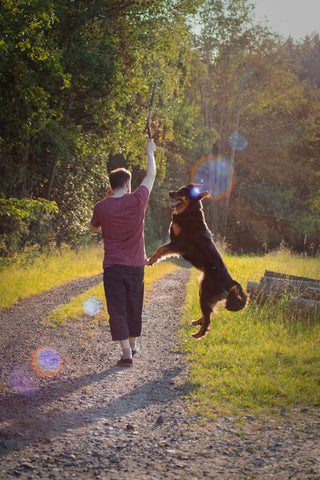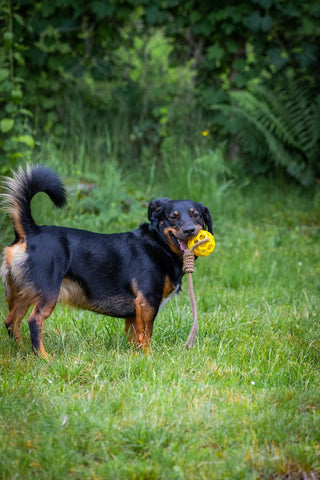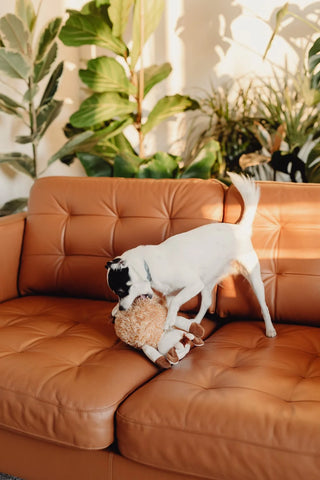How to Train Your Dog to Enjoy Playing with Toys?
The most suitable toy for your dog will depend on your dog's individual preferences, size, age and activity level.
Dogs enjoy their playtime usually when they are most active and alert. In most cases its after their first meal in morning or just before their bedtime in the evening, so these times can be ideal for playtime. However, it's important to take into consideration your dog's individual schedule and adjust accordingly.

It's also important to ensure that your dog has had enough rest and is not overly tired before starting a play session. If your dog is feeling lethargic or sleepy, it may be best to wait until they have had a chance to rest and recuperate. In general, the best time to play with your dog is when you are both feeling relaxed and have the time and energy to engage in a fun and stimulating activity together. Remember to always monitor your dog's behavior and take breaks as needed to ensure they don't become overexcited or overly tired.

Training your dog can be a fun and rewarding experience for both you and your furry friend. But just as Rome was not built in a day, no dog ever responded to the first command given to them but patience is the key. For first time dog parents, here are some tips to train your dogs to enjoy playing with toys
Start with basic commands: Start with basic commands such as "sit," "stay," "come," and "heel." These are essential commands that will help you establish a foundation for more advanced training later on.

Reward and recognition is an effective way to train your dog. Whenever your dog follows a command, reward them with dog treats, praise, or playtime. This will help your dog associate good behavior with positive experiences.
Be consistent: Consistency is key when it comes to dog training. Use the same commands and rewards every time you train your dog. This will help your dog understand what is expected of them.
Keep training sessions short: Dogs have short attention spans, so keep training sessions short and focused. Try to keep training sessions to around 10-15 minutes at a time.
Be patient: Training a dog takes time and patience. Don't expect your dog to learn everything overnight. Be patient and keep working with your dog consistently.

Avoid punishment: Punishing your dog for bad behavior is not an effective training method. It can make your dog fearful and anxious, and it can damage your relationship with your dog. Instead, focus on positive reinforcement to encourage good behavior.
Keep it fun: Training should be fun for both you and your dog. Use games, toys, and treats to make training enjoyable and engaging for your dog.
Training your dog to enjoy playing with toys can be a fun and rewarding experience for both you and your furry friend. Find the right toys: Not all dogs like the same type of toys, so it's important to find the toys that your dog enjoys playing with. Try out different types of toys, such as balls, Frisbees, plush toys, chew toys, and puzzle toys, and see which ones your dog responds to the most.
Use positive reinforcement: Positive reinforcement is an effective way to train your dog to enjoy playing with toys. Every time your dog shows interest in a toy, reward them with a treat, praise, or a game of tug-of-war. This will help your dog associate playing with toys with positive experiences.
Play with your dog: Dogs are social animals and often enjoy playing with their owners. The toy you want your dog to play with should smell of the dog parent!
Set aside time each day to play with your dog and their toys. This can include playing fetch, hide-and-seek, or tug-of-war. Make sure to give your dog plenty of praise and treats when they engage with their toys.
Make it a routine: Dogs thrive on routine, so make playing with toys a regular part of your dog's daily routine. This will help them learn to look forward to playtime and become more comfortable with their toys.

Give new toys in rotation: Dogs get bored so its always good to hide their toys and then give them the same Dog toys after few weeks. The smell makes them active and playful for the same toy.
Gradually increase difficulty: As your dog becomes more comfortable playing with toys, gradually increase the difficulty of the games and toys you use. This can include adding in puzzle toys or teaching your dog new tricks using their toys.
Remember, every dog is unique, and it may take some time to find the toys and games that your dog enjoys the most. Be patient, consistent, and use positive reinforcement, and soon your dog will be happily playing with their toys.














Leave a comment